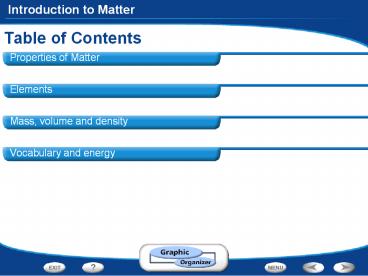Properties of Matter - PowerPoint PPT Presentation
1 / 14
Title:
Properties of Matter
Description:
Properties of Matter Elements Mass, volume and density Vocabulary and energy PROPERTIES characteristics of matter Physical properties describes a substance ... – PowerPoint PPT presentation
Number of Views:188
Avg rating:3.0/5.0
Title: Properties of Matter
1
Table of Contents
- Properties of Matter
- Elements
- Mass, volume and density
- Vocabulary and energy
2
- PROPERTIES characteristics of matter
- Physical properties describes a substance
- Physical state water freezing and changing to
ice (liquid to solid) - Texture, color, hardness what you see or feel
- Flexibility changes shape folded, coiled,
stretched - Dissolving, luster, breaking
- Volume, density and mass
3
- Chemical properties describes a substances
ability to change into different substances - Flammability catch fire or burn creates heat,
gases or ash mixes with oxygen to form
something else - Ability to react oxygen and iron create rust
silver and sulfur make tarnish - New substances gases produced during baking
(heat). Yeast and dough produce gas which causes
bread to rise
4
- Elements pure substances that cannot be broken
down into any other substance. They are the
simplest substance. - Shown as letter symbols
- C carbon
- O oxygen
- H hydrogen
- Atoms basic particle (each element has only one
kind of atom) - Can join with other atoms forming chemical bond
molecules
5
Modeling Molecules
- Describing Matter
- Models of molecules often consist of colored
spheres that stand for different kinds of atoms.
H2O
CO2
6
Weight and Mass
- Mass is the amount of matter in an object
- Your mass is ALWAYS the same no matter where you
are - Weight measures the pull of gravity on an object
- Your weight can be DIFFERENT when the gravity is
different (on the moon you would be lighter
because the gravity is weaker) - Mass is measured in grams
7
Volume Density
- Volume the amount of space matter takes up
- Depending on shape you can find it two ways
- Volume of a regular shape object is measured in
cubic centimeters - Length x width x height
- 1cm3 1mL
- Displacement method putting an irregular shaped
object in water to see how much water it pushes
away because of the space the object takes up
8
- Measuring Matter
- Density compares mass of an object to its
volume how tightly packed the molecules are. - Density Mass
- Volume
- Mass gt volume very dense object
- Masslt volume less dense object
- Waters density is 1g/cm3. Objects heavier will
sink.
9
Calculating Density
- Measuring Matter
- A small block of wood floats on water. It has a
mass of - 200 g and a volume of 250 cm3. What is the
density of the wood? - Read and Understand
- What information are you given?
- Mass of block 200 g
- Volume of block 250 cm3
10
Calculating Density
- Measuring Matter
- A small block of wood floats on water. It has a
mass of - 200 g and a volume of 250 cm3. What is the
density of the wood?
Plan and Solve
What quantity are you trying to calculate? The
density of the block __
What formula contains the given quantities and
the unknown quantity? Density Mass/Volume
Perform the calculation. Density Mass/Volume
200 g/250 cm3 0.80 g/cm3
11
Calculating Density
- Measuring Matter
- Practice Problem
- A sample of liquid has a mass of 24 g and a
volume of 16 mL. What is the density of the
liquid?
- 1.5 g/mL
12
Calculating Density
- Measuring Matter
- Practice Problem
- A piece of solid metal has a mass of 43.5 g and a
volume of 15 cm3. What is the density of the
metal?
- 2.9 g/cm3
13
Vocabulary
- Matter anything that has mass and takes up
space - Chemistry study of properties of matter and how
it changes - Chemical bond force of attraction between two
atoms - Law of conservation of matter. Matter cannot be
created or destroyed. It can be changed but NOT
created or destroyed. - Substance single kind of matter that is pure
nothing else is in it. Example sugar or salt
14
Energy
- Role of Energy for any change that happens it
needed energy - Kinetic matter in motion
- Potential energy an object has because of its
position example stretching a rubber band - Chemical energy from chemical bonds that break,
creating new bonds - Thermal energy total energy in an object,
sometimes described as hot or cold measured by
temperature. Flows from warmer to cooler - Temperature tells the amount of thermal energy an
object has































